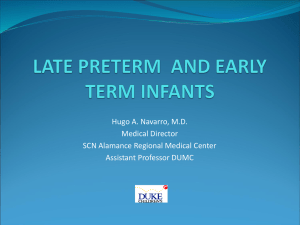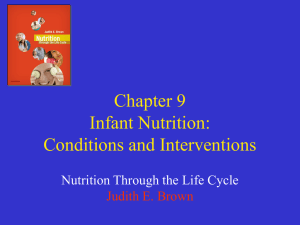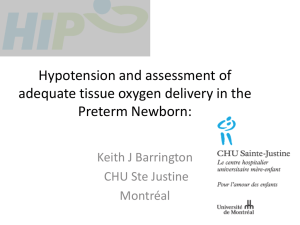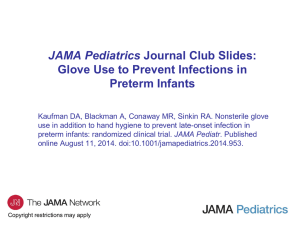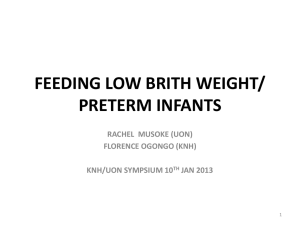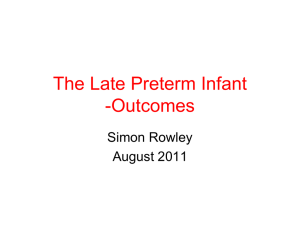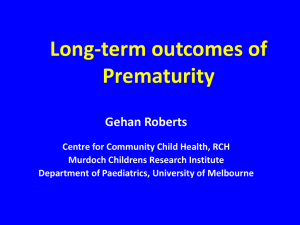F-Using UK-WHO growth charts with new born babies and preterms
advertisement
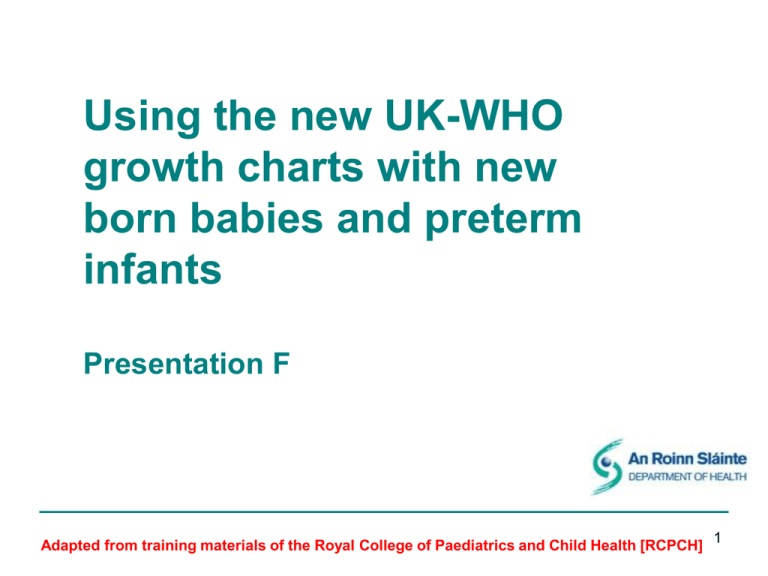
Using the new UK-WHO growth charts with new born babies and preterm infants Presentation F Adapted from training materials of the Royal College of Paediatrics and Child Health [RCPCH] 1 Plotting in the first 2 weeks • Birth weight centiles based on UK 1990 data • WHO charts start from 2 weeks • No centile lines between birth (0 weeks) and 2 weeks • Allows for weight loss and regain before week 2 2 Plotting in the first 2 weeks Plot all term infants (37 or more weeks) at age 0 weeks 3 Weighing in the neonatal period • Weigh within the first week as part of the assessment of feeding… – Early weighing does not discourage breast-feeders and may help identify problems in a timely manner – Weigh thereafter as needed • Assess early weight gain relevant to birthweight… – Most babies lose some weight after birth – Recovery of birthweight indicates that feeding is effective and that the child is well – If large weight loss or still below birthweight at 2 weeks, calculate % weight loss 4 Calculating Percentage Weight Loss It is good practice to calculate percentage weight loss on order to check exactly how much weight an infant has lost Weight Change = current weight – birth weight e.g. (2.700 kg – 2.900kg )=-200kg A fall of 200g.in weight Percentage Weight Loss = Weight loss ÷ Birth weight x 100% e.g.(200 ÷ 2.900g) x 100 = 6.9% A weight loss of 6.9% 5 Assessing neonatal weight loss • Most babies lose some weight after birth – 80% will have regained this by 2 weeks of age • Fewer than 5% of babies lose more than 10% – Only 1 in 50 are 10% lighter at 2 weeks • A baby 10% or more below birth weight at or before 2 weeks needs careful assessment for: – feeding problems – unrecognised illness 6 Summary • Plot birthweight at age 0 for all infants born 37 + weeks, • Weigh within first week as part of the assessment of feeding as early weighing... – does not discourage breast-feeders – allows timely identification of feeding problems • Assess early weight gain relative to birthweight… – Recovery of birthweight by 2 weeks suggests that feeding is effective and that the child is well – If large weight loss at any time, or still below birthweight at 2 weeks, calculate % weight loss • 10% weight loss needs careful assessment 7 Plotting Per-term infants Plotting pre-term infants using the new UK-WHO growth charts Adapted from training materials of the Royal College of Paediatrics and Child Health [RCPCH] 8 Background • A child born before 37 weeks completed weeks gestation is preterm • The WHO standard does not include data for preterm babies • The “preterm” section of the UK/WHO chart has been compiled using UK reference data for size at birth 9 Plotting on the preterm section • Use the preterm section of the UK-WHO 0-4 years chart – For infants born 32-36 weeks gestation – Up till EDD (term) plus 2 weeks • Use the Neonatal and Infant Close Monitoring (NICM) low birthweight chart – For infants<32 weeks – For any neonate needing close monitoring • After EDD plus two weeks move over to 0-1 chart with gestation age correction 10 What is Gestational Correction? • Gestational correction adjusts the plot of a measurement to account for the number of weeks a baby was born early • Number of weeks early = 40 weeks minus gestational age • Should not be used for term infants (37 weeks+) • Should be continued till – 1 year for infants born 32-36 weeks – 2 years for infants born before 32 weeks 11 Plotting with gestational correction Plot measurement at actual age Draw a line back the number of weeks the baby was early and mark this with a arrow. The arrow point should show the gestationally corrected centile When measuring frequently, plot all actual or corrected age and use arrow for a section to avoid crowding on page. 12 Transfer preterm to infancy section Born 6 weeks preterm plot on preterm section of chart until 43 weeks (EDD +2) Then plot on infancy section using gestational correction 13 Weight faltering in infant born at 34 weeks? or are the plots in the wrong place? 14 Failure to allow for gestation • Need to be clear which plots are adjusted for gestation • Other users may not adjust • Could place the child at risk 15 Summary • Preterm = birth before 37 weeks completed weeks gestation • Infants born before 32 weeks, plus any sick neonate, should be plotted on Neonatal and Infant Close Monitoring (NICM) low birth weight chart • Well preterm infants born after 32 weeks should be plotted in preterm section until 42 weeks gestation • Then plot on the 0-1 year chart using arrow drawn back method of gestational correction • Continue gestational correction till 12-24 months 16 Plotting term infants: Activity 1 Answers 17 Plotting term infants: Activities 2 to 4 Answers 18 Plotting term infants: Activities 2 to 4 Answers 19

